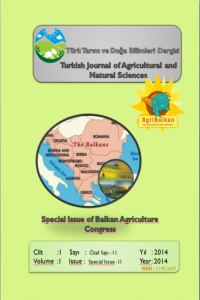Abstract
The survey is carried out on the example of Bratsigovo Bessarapski Hills in the Central south part of Bulgaria. This area is under Natura 2000, designated as Specially Protected Area, and contains entirely a proposed Site of Community Interest. For the purpose of the analysis the regional factors of sustainability are identified. An increasing part of the farms in the region are applying the High Nature Value (HNV) System. They are predominantly small-sized farms, developing traditional farming, and delivering their products mostly to the local markets. Unfortunately, the market for these value-added products is still not developed, and the farmers cannot get extra price. The main goal of the paper is to propose a market-delivery system for HNV products with a contribution to the sustainable local development. Such a system will enable farmers to get greater flexibility, a big choice in planning and realizing the sales, as well as reducing their dependence on intermediaries. The study is based on the research findings of the Bulgarian team in the frame of FP7 project entitled “Farming transitions: Pathways towards regional sustainability of agriculture in Europe” (FarmPath)
References
- Beaufoy, G. and Marsden, K.K. (2011). CAP reform 2013 last chance to stop the decline of Europe’s High Nature Value farming. [Accessed 2014] Available from http://www.efncp.org/download/policy- cap-reform-2013.pdf.
- Draganova, M., M. Peneva, Y. Kazakova, P. Mishev (2012). Case Study report: High Nature Value Farming in Besaparski Hills (Natura 2000) (Bulgaria). FarmPath working report.
- European Commission (2008). The Economics of Ecosystems and Biodiveristy – Interim report. Available from http://ec.europa.eu/environment/natur e/biodiversity/economics/pdf/teeb_repo rt.pdf
- European Commission (2009). Report on Article 17 of the Habitats Directive: Conservation Status of Habitats and Species of Community http://ec.europa.eu/environment/natur e/knowledge/rep_habitats/index_en.ht m (2001-2006).
- Gale, Fred (1997). Direct Farm Marketing as a Development Rural Development Perspectives, vol. 12, no. 2, pp 19-25. Tool, Rural
- IFOAM (2003). Developing Local Marketing Initiatives for Organic Products. [Accessed http://shop.ifoam.org from
- Marsden, T. K. (1998). “New rural territories: regulating spaces”, Journal of Rural Studies 14 (1), pp 107–117. rural
- Marsden, T. K, J. Banks, G. Bristow (2000). Food supply chain approaches: exploring their role in rural development, Sociologia Ruralis 40, pp 424–438.
- Renting, Henk, Terry K. Marsden, Jo Banks (2003). Understanding alternative food networks: exploring the role of short food supply chains in rural development. Environment and Planning A 2003, volume 35, pp 393–411.
- Tronstad, Russell et al (1995). Direct Farm Marketing and Tourism Handbook, Tuscon: Arizona Cooperative Extension, [Accessed http://ag.arizona.edu/arec/pubs/dmkt/d irectfarmmarket&tourbook.pdf
- http://ag.arizona.edu/arec/pubs/dmkt/dmkt.ht ml www.nafdma.com
Abstract
Keywords
References
- Beaufoy, G. and Marsden, K.K. (2011). CAP reform 2013 last chance to stop the decline of Europe’s High Nature Value farming. [Accessed 2014] Available from http://www.efncp.org/download/policy- cap-reform-2013.pdf.
- Draganova, M., M. Peneva, Y. Kazakova, P. Mishev (2012). Case Study report: High Nature Value Farming in Besaparski Hills (Natura 2000) (Bulgaria). FarmPath working report.
- European Commission (2008). The Economics of Ecosystems and Biodiveristy – Interim report. Available from http://ec.europa.eu/environment/natur e/biodiversity/economics/pdf/teeb_repo rt.pdf
- European Commission (2009). Report on Article 17 of the Habitats Directive: Conservation Status of Habitats and Species of Community http://ec.europa.eu/environment/natur e/knowledge/rep_habitats/index_en.ht m (2001-2006).
- Gale, Fred (1997). Direct Farm Marketing as a Development Rural Development Perspectives, vol. 12, no. 2, pp 19-25. Tool, Rural
- IFOAM (2003). Developing Local Marketing Initiatives for Organic Products. [Accessed http://shop.ifoam.org from
- Marsden, T. K. (1998). “New rural territories: regulating spaces”, Journal of Rural Studies 14 (1), pp 107–117. rural
- Marsden, T. K, J. Banks, G. Bristow (2000). Food supply chain approaches: exploring their role in rural development, Sociologia Ruralis 40, pp 424–438.
- Renting, Henk, Terry K. Marsden, Jo Banks (2003). Understanding alternative food networks: exploring the role of short food supply chains in rural development. Environment and Planning A 2003, volume 35, pp 393–411.
- Tronstad, Russell et al (1995). Direct Farm Marketing and Tourism Handbook, Tuscon: Arizona Cooperative Extension, [Accessed http://ag.arizona.edu/arec/pubs/dmkt/d irectfarmmarket&tourbook.pdf
- http://ag.arizona.edu/arec/pubs/dmkt/dmkt.ht ml www.nafdma.com
Details
| Primary Language | Turkish |
|---|---|
| Journal Section | Research Articles |
| Authors | |
| Publication Date | March 1, 2014 |
| Submission Date | January 26, 2015 |
| Published in Issue | Year 2014 Volume: 1 Issue: Özel Sayı-2 |

